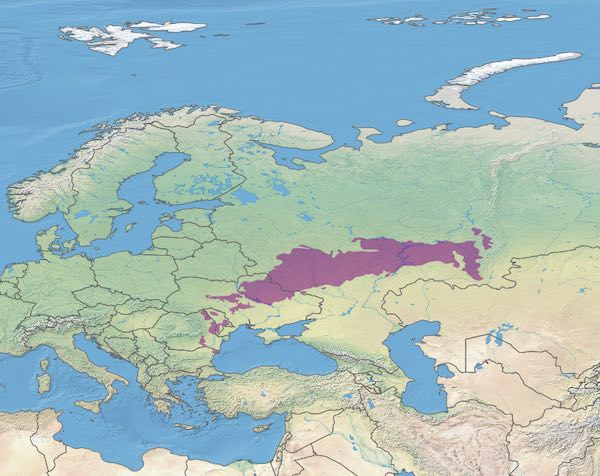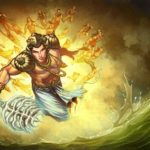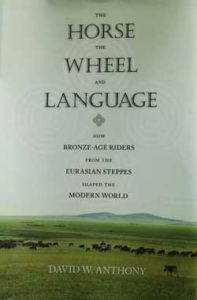
A new paper for David Anthony mentions something which I had missed:
The currently oldest sample with Anatolian Farmer ancestry in the steppes in an individual at Aleksandriya, a Sredni Stog cemetery on the Donets in eastern Ukraine. Sredni Stog has often been discussed as a possible Yamnaya ancestor in Ukraine (Anthony 2007: 239-254). The single published grave is dated about 4000 BC (4045–3974 calBC/ 5215±20 BP/ PSUAMS-2832) and shows 20% Anatolian Farmer ancestry and 80% Khvalynsk-type steppe ancestry (CHG&EHG). His Y-chromosome haplogroup was R1a-Z93, similar to the later Sintashta culture and to South Asian Indo-Aryans, and he is the earliest known sample to show the genetic adaptation to lactase persistence (I3910-T).
The sample goes back to 2017 paper.

As you know the R1a1a-Z93 is the sub-branch of R1a1a that is common outside Europe (Central Asia & South Asia). A previous sample was dated to 3,800 years ago from a Sbruna sample, and it is rather common on the Central Asian steppe of the period as evidenced by ancient DNA. The details of its intrusion (or lack thereof  as some might say) into South Asia have not been fully elucidated by ancient DNA, but they likely will be soon.
as some might say) into South Asia have not been fully elucidated by ancient DNA, but they likely will be soon.
Additionally, the I3910-T mutation is known to share identity-by-descent between people in South Asia and in Europe. That is, the mutation in both populations is due to a common ancestor.
What is the relevance of having 20% Anatolian farmer ancestry? Saw it on eurogenes as being of some significance but I can’t seem to figure it out.
Is it because of Pontic-steppe vs. Anatolian home land debate?
Or that hypothesis of Z63 is coming from south of Caucasian mountains?
IIRC, I think it’s about the latter. The 20% Anatolian farmer ancestry or whatever at that period around 4000 BC I think is code for the European Chalcolithic or similar ancestry from cultures like Cucuteni-Tripolye, etc. that lied just west of the Pontic-Caspian steppe. This is used by people to argue against the possibility of direct migrations of Indo-Iranians or whoever into India from south of the Caucasus according to the Armenian model (people also argue against the Armenian origin for Proto-Indo-Europeans but that is a different thing).
“Anatolian farmer” in general is connected with Europe beginning from any time starting from 6000 BC or so while “Iranian farmer” is connected with Iran, Central Asia and India during the same period.
Thanks Santosh.
So, Anatolian farmer is same as EEF? Early European farmers being the first ones to come from Anatolia?
Yeah, I think so.
Yup, confirming what was postulated by Max Mueller all along. Anyway, I find the attachment to this issue very strange, especially among those in the “whiter groups” that talk about being descendants of indo aryans . They are correct that they are. But at most it peaks at like 30%, so the majority DNA of essentially every single S Asian is not indo aryan, yet these people really focus on that aspect of their ancestry.
People that want to deny the theory all together are annoyed that it pokes a big hole into their Hindu Nationalist= Indian Nationalist because Hindu civilization is entirely indigenous to the subcontinent propaganda campaigns.
All in all, people just have to accept that first S Eurasian huntergatherers distantly related to australian aboriginals, Melenesians, and Andamese first colonized the subcontinent.Then neolithic farmers from present day Iran arrived and brought agriculture. Additionally, they mixed with locals and founded the famed Indus Valley Civilization. As it went into decline, perhaps due to Malthusian constraints secondary to unfavorable weather patterns, indo-aryans from Central Asia arrived. They slowly assimilated and often subjugated the locals into a racialized caste system.
Besides some back migration of SE Asians, very little strong genetic input broadly impacted the subcontinent, from then on. The end result was a thoroughly mixed people and a religion that combined practices from all three groups that has come to be known as Hinduism.
That’s the dominant & combative way people discuss the issue but these issues can be discussed from completely different perspectives as well –
What constituted Hinduism then or what existed then can it be linked to Hinduism ? When these people came they did not come with religious identity rather they were tribal warriors which makes that period fairly different from the period when religious identities gained prominence.
E.g. – Tribal groups are smaller hence they don’t play diplomatic games instead their conflicts & resolutions are reactionary & immediate but identities with large numbers make people do things subtly which can be termed as disingenuous or cunning & thus create a perpetual sense of paranoia & distrust {as in the modern multicultural world}.
What if both people were just hunters, gathers or wanderers so how these identity-less people can be equated with people who are constantly fighting in the name of Identities ?
Is there sufficient proof that these same people called themselves Arya without outside influence or it became incorporated into Indian language due to presence & contact with Iranians later ?
There are many ways these issues can be discussed without repeating the dominant narrative but let’s not do that instead wait for some scholar to write a book questioning the dominant narrative & then we can look deeper into the existing or prevailing narratives.
@thewarlock Your theory of Caste system lacks the perspective of existing people in India of how they interacted and what was their role in creating Hinduism as well as Caste & single handedly puts all blames on ‘Aryan intruders’ which is false based upon latest archaeological & other studies.
always willing to learn more (no sarcasm). What does the most recent research show about the origin of caste? Is there something to show it predates Indo-Aryans? If so, why does proportion of Indo-Aryan DNA, generally speaking, correlate to caste, when controlling for recent migrations and geographic zone? I am aware of some group exceptions like Haryana Jatts having an oddly high amount. I thought that was postulated to be because they immigrated from modern day Pakistan as a second wave, perhaps fleeing Islamic invasion, to the Northern Gangetic Plains. They assimilated into the shudra role, giving the social strate had already been established by the first group of indo aryan migrants, who had already placed themselves on the top of the social hierarchy.
I keep replying about Caste from multiple sources of studies from Language, epigraphical & archaeological etc. here are some papers that might help you understand the give & take processes which were employed regionally & varied spatially.
https://www.academia.edu/37740094/Social_Life_Issues_of_Var%E1%B9%87a-J%C4%81ti_System
Jan E.M. Houben*
Linguistic Paradox and Diglossia : the emergence of Sanskrit and Sanskritic language in Ancient India
https://doi.org/10.1515/opli-2018-0001 – Open source
Received December 1, 2017; accepted February 20, 2018
https://www.academia.edu/39835167/Bangladesh_National_Museum_Metal_Vase_Inscription_of_the_Time_of_Dev%C4%81tideva_and_its_Implications_for_the_Early_History_of_Harikela
Cambodia Inscription translation –
http://www.yosothor.org/uploads/images/Udaya/Udaya_pdf/Udaya-Yosothor/No-14-2019/05_Goodall_Udaya%2014_Final.pdf?fbclid=IwAR16wtgmvQxlSLOYV6JfDflNWZuOcR3_LhC2un6e3CZhEwT6Iyfpx5nUP8E
It was not something that these supposedly ‘R1a Aryans’ came with & implemented over the rest of the Indians to put themselves to top of social hierarchy.
Furthermore i would like you to engage with the following videos –
https://www.youtube.com/watch?v=DhAqh4RFpDc
Watch all 3 parts of the above talk by Kesavan Veluthat & notice the part where he discusses how Upanishads were a revolt against Brahmins by warrior class.
Or ask yourself why people know about Hindu literature that mentions Caste divisions but not about the literature that contradicts it or opposed it & is validated by same scholars who validated the other parts of these texts, like –
https://en.wikipedia.org/wiki/Vajrasuchi_Upanishad – Questions all forms of social divisions.
https://en.wikipedia.org/wiki/Apastamba_Dharmasutra – Gives prominence to existing practices of communities over Vedas.
Point is formation of Caste was a result of varied local factors & not because of religious belief or outsiders. While religious order co-opted these tribalistic beliefs to gain trust of communities of the region just like Christianity as Islam has done to some extent but they had central unchanging tenets of beliefs & a central religious Identity unlike Hinduism as it was non-existent when these processes happened in India in earlier periods.
“They slowly assimilated and often subjugated the locals into a racialized caste system.”
Is caste really an Aryan thing? It’s not present in Europe or Iran, for example. Moreover, the genetic evidence seems to indicate that caste only began to take root around ~500AD, about ~2,000 years after Aryan migration.
No word about Vinca. Even in the paper with almost 100 authors, no word about Vinca. Description of moving people from Yamnaya to Balkan, not saying that at that time the literacy was there for almost couple thousands of years. And so many mentioning of Indo-European (languages) without explanation of its meaning.
I would like to share with you my brief (25 minutes in total) encounter with eurogenes blog which was referred by Razib. This blog was dedicated to ‘The PIE homeland controversy: August 2019 status report’ based on the paper of archaeologist David Anthony. There were more than 300 comments but I realised that there are actually not more than 10 people who make 60-70 comments. They discuss everything, from Chukotka to Basque, often extensively citing genetic result and often speculating about various linguistic and civilizational issues. I read the article, intro text and many comments. The major discussion topic was search for Proto Indo-European homeland and in this context Yamnaya, Corded Ware and Bell Beaker. As I mentioned before I could not see any mentioning of Vinca and Lepenski Vir.
I sent a longer comment, but, surprisingly, it was not published. Later, I sent couple one-line comments which were published. I’ve mentioned Vinca stating that was a civilisation much earlier than CW and BB and my opinion that this was PIE homeland. It is amazing that CW&BB are on the half way btw us and Lepenski Vir!!!. I also mentioned R1A genes in Europe. Immediately, the Moderator reacted and asked me to provide a proof about R1A in Balkan. He gave me couple hours, otherwise I would be banned. I immediately start sending links with documents, including bellow links to Vinca and Lepenski Vir where can be seen the level of this oldest European civilisation and convince readers that it is a legitimate candidate for PIE Homeland. After only 5 minutes he changed mind and announced that I am banned and started deleting my links and comments. I asked him to explain this, but he did not publish my question.
I read some previous comments to see what’s happening and found his conversation with some commentators – you are f*ucking crazy, are you on drugs, if the author is not crazy yet, he will be after reading your comment, etc.
But I found one comment directed to the Moderator: “You get aggressive when you get into a discussion which you know you were wrong about. I thought you were different than those provocative trolling admins at Anthrogenica, these guys don’t care about the truth, when it doesn’t fit their agenda, they start cursing or banning the person they are discussing with… This is not related to any kind of a civilized scientific discussion!”
Vinca figurine photos (5-6000 BC):
https://www.google.com/search?q=vinca+figurine+photos&tbm=isch&source=iu&ictx=1&fir=r-3bezUbacgpRM%253A%252CZeCD4C_76L0gRM%252C_&vet=1&usg=AI4_-kTwsJWtCkB8H3bCYN_QZhJxYjkPYg&sa=X&ved=2ahUKEwi9ncHHj_PjAhXWgUsFHV0pB2AQ9QEwAHoECAkQBg#imgrc=r-3bezUbacgpRM:
Lepenski Vir the oldest urban settlement in Europe (8000 BC).
https://www.google.com/search?q=lepenski+vir+civilisation+photos&tbm=isch&source=iu&ictx=1&fir=Y2WcKQB0ft2A5M%253A%252C0a1NzJ7fAskBdM%252C_&vet=1&usg=AI4_-kRV0mAD9w4H9-_IiAAYQmzV9PZYwg&sa=X&ved=2ahUKEwjI3_SAxvDjAhWObysKHTz-AowQ9QEwAHoECAkQBg#imgrc=Y2WcKQB0ft2A5M
I found some interesting comments related to the topic:
What people don’t seem to be able to face, however, is that it is now almost certain that Yamnaya was not I.E.
So, what if two consecutive migrations brought IE languages to India? However, the Steppe can’t have been the original PIE homeland: A Steppe homeland can’t explain shared PIE agricultural vocabulary. A Steppe homeland leaves early IE branches unaccounted for.
How would an IE in India and Europe from the neolithic both get identical loans of securely Copper Age terms?
Genetic fully support this (R1a M417 in SS and likely R1b L-51 in the westernmost part of the steppe and maybe even in Romania and surroundings) – MT: Lepenski Vir is 100m from Romania, on the other side of Danube.
Anthony demonstrated a very competent and up to date understanding of the currently available data. He was also very fair and reasonable in his assertions. In the process of being fair he did a better job of arguing against a PIE homeland on the steppe than for it by providing a detailed description of the cultural impact of balkan neolithic farmers and maikop on the steppe people. Animal domestication, metallurgy, wheeled vehicles, were all an import onto the steppe from these neolithic farmers. The core concept of the steppe hypothesis is based on attaching a reconstruction of the PIE language to a candidate culture based upon the origin of these cultural elements none of which are native to the steppe.
The Moderator (my impression is that he is a geneticist) who, it seems, is been doing this job for several years, says – Well, I for one, no longer have a PIE homeland theory. – ?????
What I have learnt from this excursion to eurogenes? It was my first-hand experience with treating Vinca as a taboo topic. I read before that, for e.g., that during one International Conference in Belgrade in 60ies about Vinca, it was requested by ‘Europeans’ that the oldest, newly found alphabet in the world be named ‘South-eastern European script’ instead of Vinca’s script. It was rejected but because of this ‘Europeans’ boycotted this finding and haven’t updated their textbooks where is still the oldest Sumerian script. Also, one scientist told me that another taboo topic among Euro-scholars is mentioning Proto-Slavic ancestors. It is ok to talk about Proto-Germans, proto-anything but not about proto-slavic.
After all, it becomes clearer (to me) why scientists for 200 years cannot find who were Aryans and where was their homeland. I have noticed couple (OIT) BPs commenting there. They fight uphill battle (Moderator told them that they lost battle (!) 1800 BC!!!). Good lack to them. They should be knowing who their allies are even if they have different opinion.
To finish with one comment from this blog:
“Only racism and political bias at this point prevent many to see the full picture ……it is all there in front of us.”